
Cartridges, read-errors and RAID.... the best phono-cartridges for needle-drops
Introduction
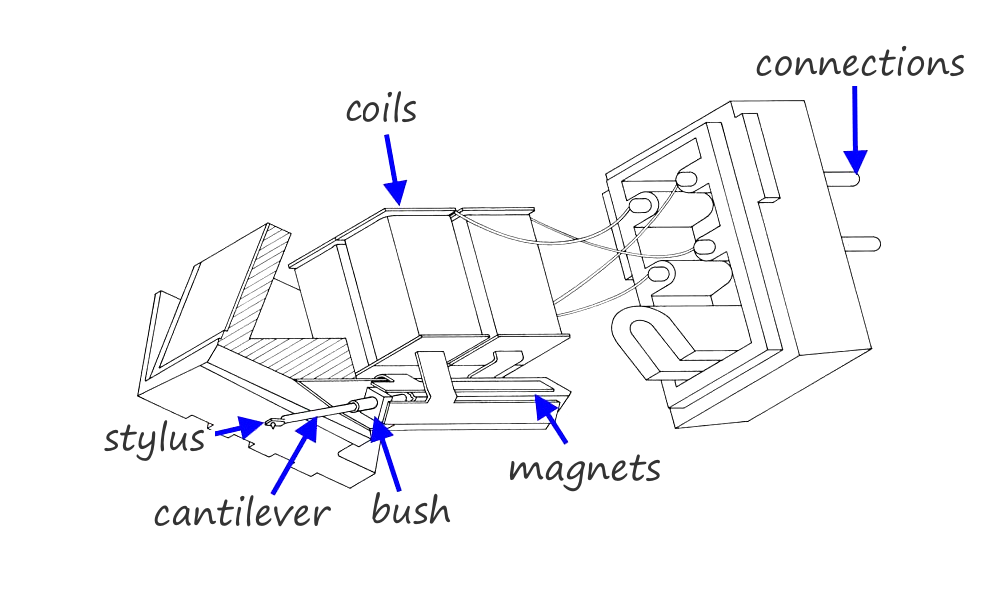 When a gramophone (or phonograph) record is played, the stylus traces the wiggly grooves and the assembly is arranged so that the movements of the stylus are communicated via the cantilever to move a coil and a magnet relative to one another thereby generating a small electric current.
When a gramophone (or phonograph) record is played, the stylus traces the wiggly grooves and the assembly is arranged so that the movements of the stylus are communicated via the cantilever to move a coil and a magnet relative to one another thereby generating a small electric current.
Either the cantilever moves a small magnet near a coil, in which case the cartridge is termed a moving-magnet type: or, a very small coil is contrived to move in a magnetic field, in which case the cartridge is called a moving-coil type. This latter type is very inefficient and produces only a very small signal compared with the moving-magnet pickup. In a stereo cartridge, there are two coils and two magnets; one for each channel.
Moving-magnet and moving-coil cartridges compared
Most vinyl-record enthusiasts share a belief that the more expensive moving-coil (MC) type cartridges outperform the moving-magnet (MM) type, in spite of the inconvenience of the former type which generates a very low output signal and thereby require a special head-amplifier or transformer stage before the signal can be fed to a normal phono preamplifier.
Enthusiasts of MC cartridges will tell you the principal advantages of this more expensive type are:
- Lower noise
- Sweeter top-end
- Better stereo image
Frankly, here at Phædrus Audio we shared these beliefs and have only recently challenged them when our colleagues at Pspatial Audio came to us as they developed their Stereo Lab software.
Read errors
Although Pspatial Audio simply started with the concept of developing phono equalisation in software This turned out only to be the beginning. In subsequent work they have developed methods to reduce the worst "clicks and pops" without damaging the audio (certainly the biggest drawback of all analogue discs). And discovered that much of the harmonic distortion generated in the replay of LPs may be calculated and subtracted from the audio - greatly enhancing the clarity of the medium; especially towards the centre of the record.
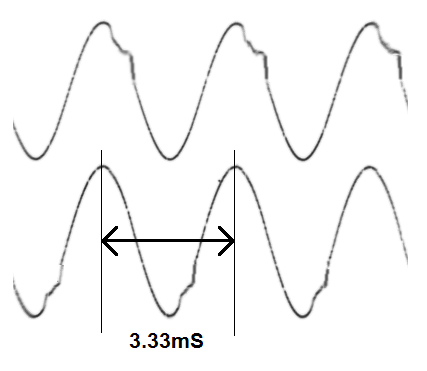 But one fault in the reproduction of records which cannot be corrected in software is poor tracking, this being the phenomenon in which the stylus parts company with the groove wall due to it being too inert to accelerate to the velocities demanded by a heavily modulated groove.
But one fault in the reproduction of records which cannot be corrected in software is poor tracking, this being the phenomenon in which the stylus parts company with the groove wall due to it being too inert to accelerate to the velocities demanded by a heavily modulated groove.
The brief pops and clicks which plague records may be concealed in software because these disturbances last only a few samples at a time, but poor tracking can cause the stylus to leave contact for a period much too long to correct. For example, in a typical failed tracking test, the stylus leaves the groove for about a third of a cycle on a high-velocity 300Hz signal. That's a period of 1mS. At 96kHz sampling, 1mS is represented by 100 samples. Under normal circumstances of audio replay, it's anybody's guess what those 100 samples ought to have been.
In modern data-processing terms we can think of poor tracking as "read-errors" which are impossible to correct or conceal. (See illustration left.)
And frankly these read errors are the least of the issues. For every time a stylus fails to accelerate fast enough and loses contact with the groove wall, it also fails to "move out of the way" of the next bend in the plastic groove. The result is damage to the record. When mistracking is present it isn't just the data that's getting trashed!
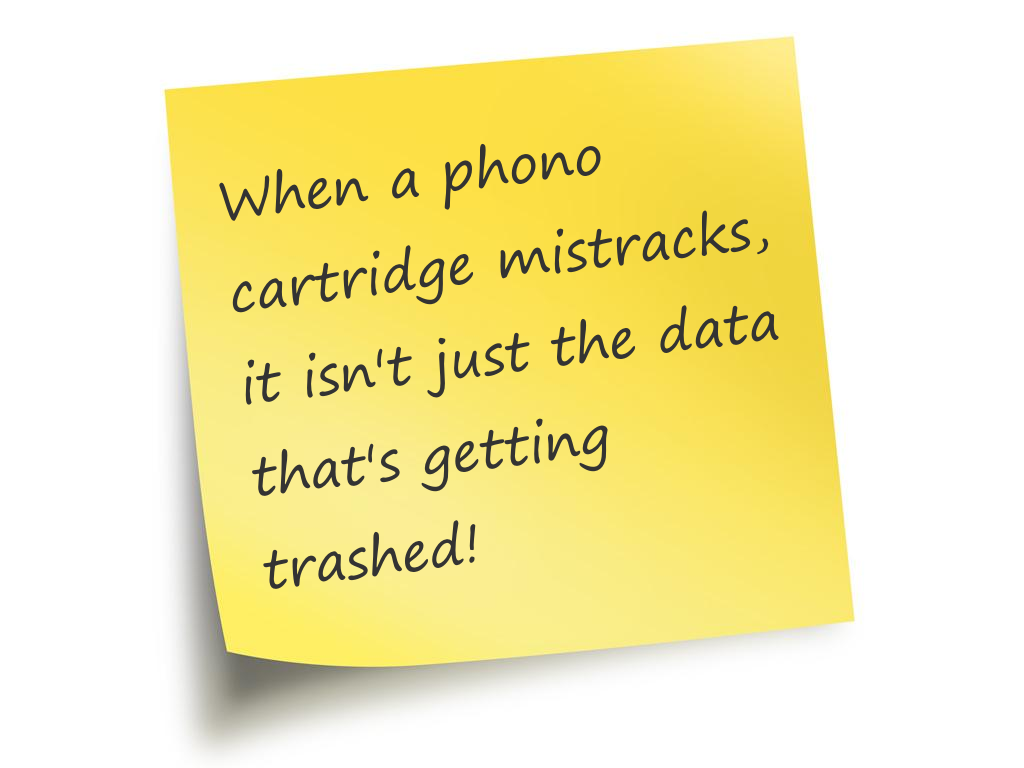
Tracking is king
Pspatial Audio therefore developed a real aversion to poor tracking in phono cartridges and embarked upon a more serious and fundamental study of various types a models of phono cartridge to investigate their performance in this regard. The results, to - their and our - great surprise, revealed that MC cartridges do not (as a general rule) outperform MM types in terms of tracking. We had wrongly attributed the sweeter top-end to better tracking from the MC type cartridge. In fact, Pspatial Audio discovered that some very expensive MC cartridges are actually very poor in terms of tracking: and some very modest MM types are exceptionally good.
Electronics to the rescue.....
Pspatial Audio discovered that the "villain of the piece" in the moving magnet cartridge is the inductive nature of the pickup's impedance. It is this impedance which causes all the problems with this type of cartridge.
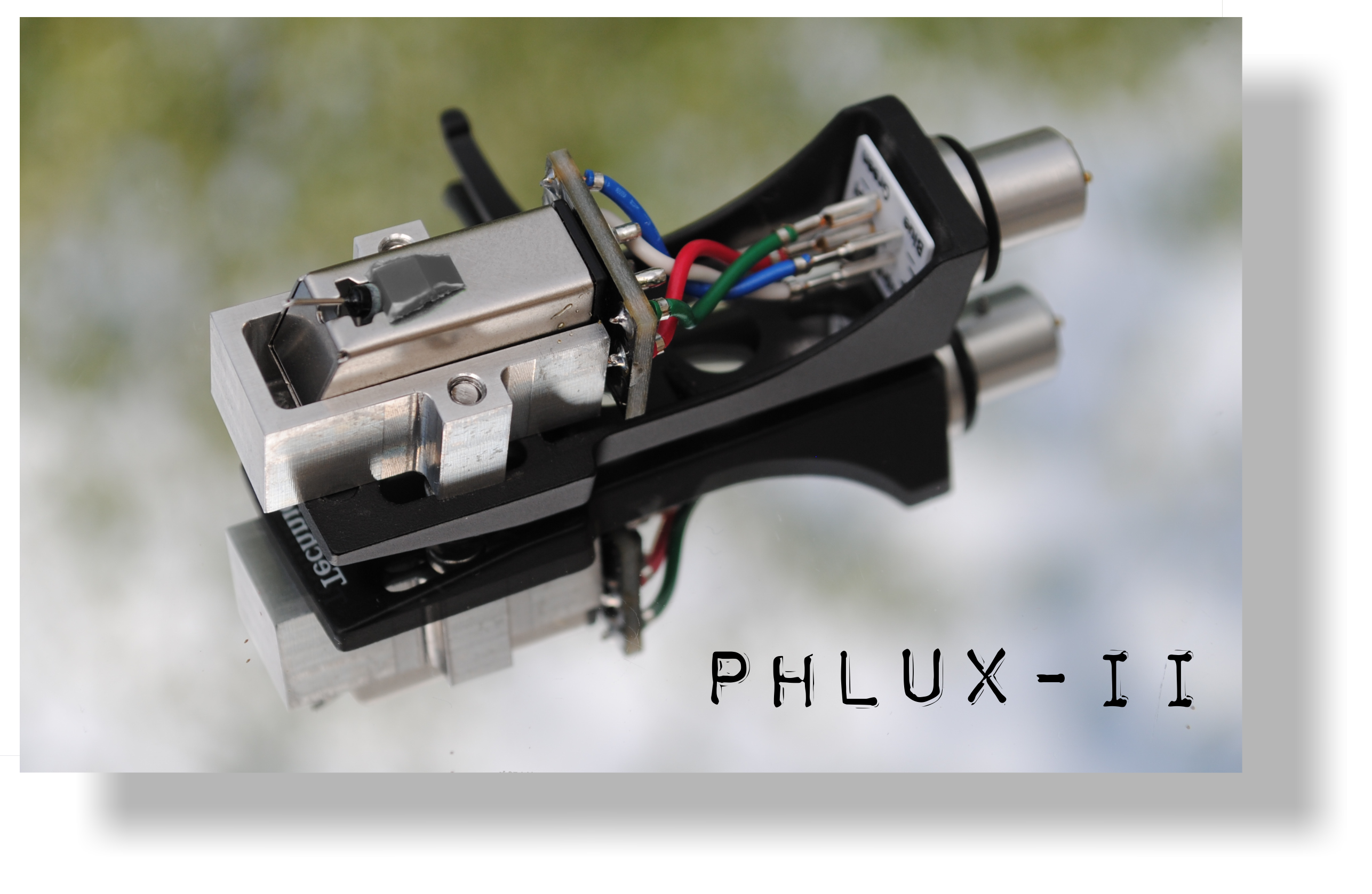 Pspatial Audio realised that all the drawbacks of the MM type could be addressed if a small amplifier could be fitted to the back of the cartridge itself and they came to us to see if this could be developed into working prototype.
Pspatial Audio realised that all the drawbacks of the MM type could be addressed if a small amplifier could be fitted to the back of the cartridge itself and they came to us to see if this could be developed into working prototype.
They made the condition that this head-amplifier needed to be remotely powered via the signal leads (like a microphone on phantom power). After all, it would be trivial to arrange for a small amplifier stage in the headshell if extra wires could be fed down the arm to provide the ciruit with power supplies. But this would preclude this technique from the vast majority of turntables without extensive and delicate re-work.
Our solution to this challenge is the PHLUX cartridge.
We recommend the PHLUX for all needle-drops: it's the cartridge we developed to get the very best results possible with Stereo Lab software. But it has wider application in any high-quality phono system.
Mono phono-cartridges and RAID 1 hard-drives.....
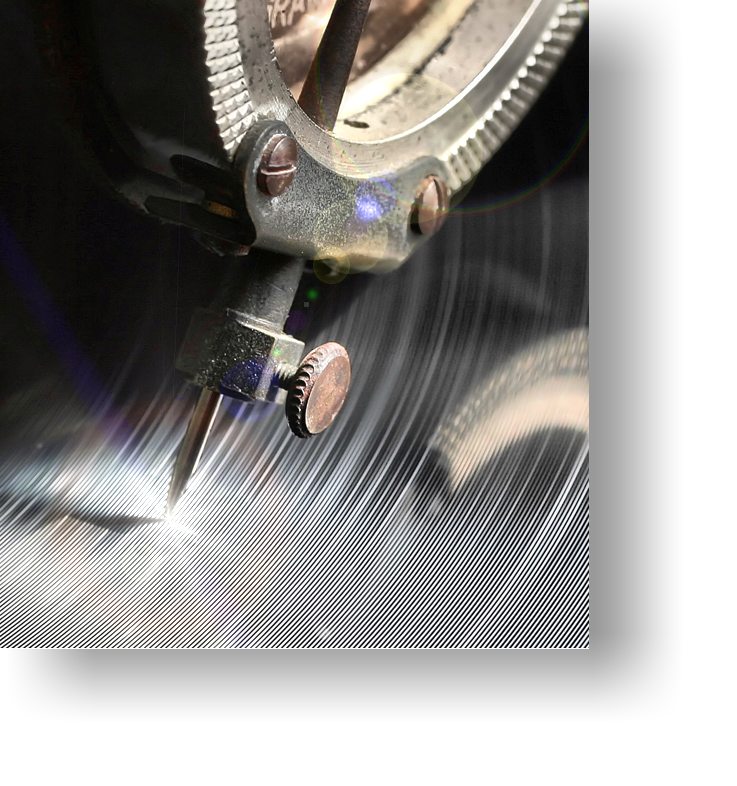 A mono gramophone (phonograph) record captures the music in side to side (lateral) modulations of the groove. This is retained in a stereo record, but the extra stereo (channel-difference) information is modulated by supplementing the side to side "wiggles" of the mono signal with up-and-down (vertical) stylus movements. The diagram below illustrates the concept.
A mono gramophone (phonograph) record captures the music in side to side (lateral) modulations of the groove. This is retained in a stereo record, but the extra stereo (channel-difference) information is modulated by supplementing the side to side "wiggles" of the mono signal with up-and-down (vertical) stylus movements. The diagram below illustrates the concept.
Another way to formalise this is to say that the inner groove-wall carries the left-channel information, and the outer groove-wall carries the right-channel information.
The interest in historic, monaural recordings on vinyl and shellac records has prompted several phono-cartridge manufacturers to release mono phono-cartridges. Some models are even specialised for 78 RPM records. With larger styli and limited frequency response, these low-compliance cartridges can track with a greater down-force than a conventional cartridge and thus are designed to respond only to lateral modulation.
For simple listening pleasure in a purist, all-analogue set-up, these cartridges may represent a fine investment. But they are sub-optimal for needle-drops intended for Stereo Lab.
Mono discs and RAID 1
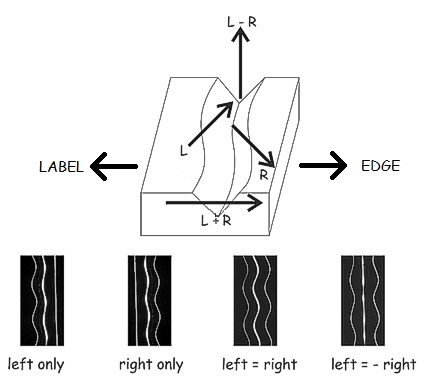
Because we can say that the left and right signals on a stereo LP are carried in the left- and right-hand walls of the V-shaped groove, we can equally say that, in a mono record, the same information (the mono signal) is carried twice. A mono disc has thereby a built-in 100% redundancy in its encoding of the original signal.
A mono gramophone record can be thought of as RAID 1 hard-drive!
Inside the DSP of Stereo Lab, Pspatial Audio use this informational redundancy to advantage. For example, it helps them detect where groove damage has occured and how to conceal it, and it plays a significant role in the detection and correction of geometrical distortion mechanisms. They also use this redundancy to analyse statisically the difference (left minus right) signal for its peak and RMS values which tells us a great deal about the condition of the disc and permits us to set various parameters automatically.
A specialised mono cartridge simply scans the two signals from the left-hand wall and from the right-hand wall and generates a signal which is the geometrical average of the two inscribed modulations. In so doing, the redundancy is lost .
We therefore recommend the PHLUX active moving-magnet cartridge for all historic needle-drops. The PHLUX is particularly suitable for enthusiasts of historic recordings because after-market styli are available for 78 RPM records. A suitable stylus for all 78 recordings is available here.

Links
Back to home page
Address all mail to sales@phaedrus-audio.com


Maidstone . Kent . UK .
© Phædrus Audio 2016. All rights reserved.
 When a gramophone (or phonograph) record is played, the stylus traces the wiggly grooves and the assembly is arranged so that the movements of the stylus are communicated via the cantilever to move a coil and a magnet relative to one another thereby generating a small electric current.
When a gramophone (or phonograph) record is played, the stylus traces the wiggly grooves and the assembly is arranged so that the movements of the stylus are communicated via the cantilever to move a coil and a magnet relative to one another thereby generating a small electric current.

 A mono gramophone (phonograph) record captures the music in side to side (lateral) modulations of the groove. This is retained in a stereo record, but the extra stereo (channel-difference) information is modulated by supplementing the side to side "wiggles" of the mono signal with up-and-down (vertical) stylus movements. The diagram below illustrates the concept.
A mono gramophone (phonograph) record captures the music in side to side (lateral) modulations of the groove. This is retained in a stereo record, but the extra stereo (channel-difference) information is modulated by supplementing the side to side "wiggles" of the mono signal with up-and-down (vertical) stylus movements. The diagram below illustrates the concept.


